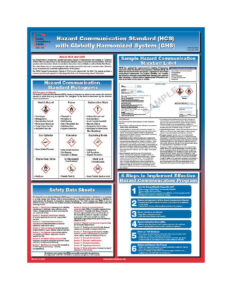The Globally Harmonized System of Classification and Labelling of Chemicals (GHS) is a set of internationally agreed-upon standards for classifying and communicating the hazards of chemical products. GHS hazard communication plays an essential role in protecting workers and the environment from the potential hazards associated with hazardous chemicals.
A GHS hazard communication program template can help you develop a comprehensive and effective program that meets the requirements of the GHS and other applicable regulations. This template provides a step-by-step guide to creating a program that includes:
Creating a GHS Hazard Communication Program
The first step in developing a GHS hazard communication program is to identify the chemicals that are used or handled in your workplace. Once you have identified these chemicals, you need to obtain safety data sheets (SDSs) for each chemical. The SDSs will provide you with information about the hazards of the chemical, including its physical and chemical properties, health effects, and environmental impacts.
Once you have obtained the SDSs for all of the chemicals in your workplace, you need to review them and identify the hazards that are associated with each chemical. You should also consider the potential for exposure to these hazards and the consequences of exposure.
Based on the information you have gathered, you need to develop a plan for communicating the hazards of the chemicals to your employees. This plan should include:
- A system for labeling containers of hazardous chemicals
- A training program for employees who work with hazardous chemicals
- A system for providing information about hazardous chemicals to employees and other interested parties
Implementing a GHS Hazard Communication Program
Once you have developed a GHS hazard communication program, you need to implement it in your workplace. This includes:
- Labeling containers of hazardous chemicals with the appropriate hazard labels
- Training employees who work with hazardous chemicals on the hazards of the chemicals and the protective measures that they need to take
- Providing information about hazardous chemicals to employees and other interested parties
- Maintaining a record of the training that has been provided to employees
- Updating the hazard communication program as new information about hazardous chemicals becomes available
It is important to note that a GHS hazard communication program is an ongoing process. As new chemicals are introduced into your workplace, you need to update your program to reflect the hazards of these chemicals. You also need to provide refresher training to employees on the hazards of the chemicals that they work with.
Following these steps can help you ensure that your workplace has a comprehensive and effective GHS hazard communication program. This program will help to protect your employees and the environment from the potential hazards associated with hazardous chemicals.
